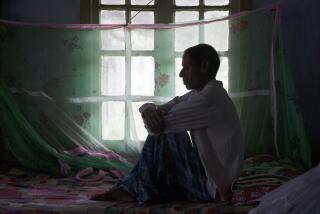Drugs for Latent TB Carry Risks, Doctors Told
WASHINGTON — Five patients died of liver failure and 16 others were hospitalized after they took a standard two-drug regimen to treat latent tuberculosis infections, federal health officials reported Thursday.
The cases came only months after the government reported two cases of similar liver damage--one fatal--in patients who had taken the drugs.
As a result, the Centers for Disease Control and Prevention and the American Thoracic Society urged Thursday that use of the drug combination to treat latent TB be sharply curtailed and that any patients who continue taking the two drugs be closely monitored for signs of liver problems.
Latent TB occurs when a patient is exposed to the bacterium that causes tuberculosis and carries the infection but is not infectious to others or showing symptoms.
Such patients are routinely treated with antibiotics because they risk developing the disease later in life.
The drugs under scrutiny have been used for 30 years to treat active TB with few problems but have been used to treat latent TB only for the last year.
Officials do not know why these problems have developed with the treatment of latent infection.
Nevertheless, “we’re taking these steps to alert the public, to avoid more injury and deaths,” said Dr. Kenneth Castro, director of CDC’s division of TB elimination.
Years of Successful Treatment Reconsidered
As many as 15 million people in the United States are infected with latent TB, but it is not known how many of them are taking the drugs. Tuberculosis is an infection of the lungs. A person can become infected by inhaling bacteria released into the air when someone with TB coughs, sneezes or shouts.
Cases of tuberculosis in the United States always have been low compared with other countries, in part because of widespread TB testing and aggressive treatment of those with positive skin test results. Last year, the United States reported an all-time low of 16,377 cases of active tuberculosis.
But federal health officials are now rethinking treatment recommendations in light of the possible risk from the drugs.
The treatment involves taking rifampin and pyrazinamide (RIF-PZA) for two months. Cases of liver damage, including the two reported by CDC in April, developed in some patients only weeks after they started treatment, Castro said.
Another antibiotic, isoniazid (INH), is used for nine months and is effective. But it also has been linked to liver problems and is under investigation, although physicians now regard it as safer than RIF-PZA.
The CDC recommended that most patients diagnosed with latent TB switch to INH, unless their physicians think they will not be able to stick to a nine-month treatment schedule or if they are believed to be at high risk of developing active disease.
The risk of developing active TB is highest among those who also are infected with the virus that causes AIDS or have some other medical condition that may increase their chances of becoming ill.
Others vulnerable include those living or working in high-risk settings, such as homeless shelters, correctional facilities, nursing homes and hospitals, as well as people with a history of substance abuse, those who come from countries where TB is common or those who have had a known recent exposure to a person with active TB.
Blood Tests Ordered to Monitor Liver Toxicity
“The risk from going from latent to active is highest in the year after that exposure occurs,” Castro said. “Treatment for latent TB is very important: It helps keep people from developing full-blown TB, and once you have it, that chain of infection develops. And without treatment, you could die.”
For those who must continue taking the two-drug regimen, the CDC recommended they undergo blood tests every two weeks to check for liver toxicity.
Also, the agency urged physicians to fully explain the drugs’ risks to patients, so they are aware of the symptoms of liver problems--abdominal pain, fever, malaise, fatigue, vomiting and jaundice.
“It’s very important that if they have these symptoms, they stop taking the drugs immediately, then call the doctor,” Castro said. “We saw in some instances, very sadly, that some people had symptoms but had trouble reaching their doctors and kept taking the drugs.”
The agency also recommended that doctors prescribe no more than a two-week supply at a time to ensure that patients return for blood screenings.
Those with a history of alcoholism, liver disease or who take other medications that pose a danger to the liver should not take these two drugs, the CDC said.
The Food and Drug Administration said it is reviewing the cases of liver toxicity reported in the use of the two-drug combination. Both drugs were licensed within several weeks of each other in 1971. The FDA is not expected to remove the drugs from the market because they are effective in treating active tuberculosis.
“I would hate to see that, because those who have active TB really need this treatment,” Castro said. “They will run the risk of dying if they don’t get treated.”
Typically, active tuberculosis is treated with four drugs during the first two months: RIF, PZA, INH and a fourth antibiotic, either ephambutol or streptomycin, and then four months of only RIF and INH.
“We have seen some side effects from this regimen, but the risk/benefit here is very different,” Castro said. “And the frequency of side effects seems to be lower [in the active TB drug regimen] for unclear reasons.”
The 21 patients in the most recent report ranged from age 28 to 73, and 12 of them were men. None received a liver transplant. The 16 patients hospitalized later recovered.
One of the hospitalizations occurred in California, said Lea Brooks, a spokeswoman for the California Department of Health Services. The patient, whose name, gender, age and residence were not available, suffered liver problems but survived.
Latent TB Cases Not Tracked by L.A. County
State health officials are exploring several cases of liver toxicity among patients with latent TB to determine whether there is a link to this drug regimen or another therapy, Brooks added.
The Los Angeles County Department of Health Services was unaware of any deaths or hospitalizations that resulted from the drug regimen, officials said.
One problem, they added, is that doctors are not required to report cases of latent TB to the county Health Department, only cases of active TB.
The CDC emphasized that all of the treatments used against tuberculosis have been associated with liver problems in some patients and stressed that “careful monitoring during treatment is important to avoid severe damage.”
*
Times staff writer Charles Ornstein in Los Angeles contributed to this story.
More to Read
Sign up for Essential California
The most important California stories and recommendations in your inbox every morning.
You may occasionally receive promotional content from the Los Angeles Times.










